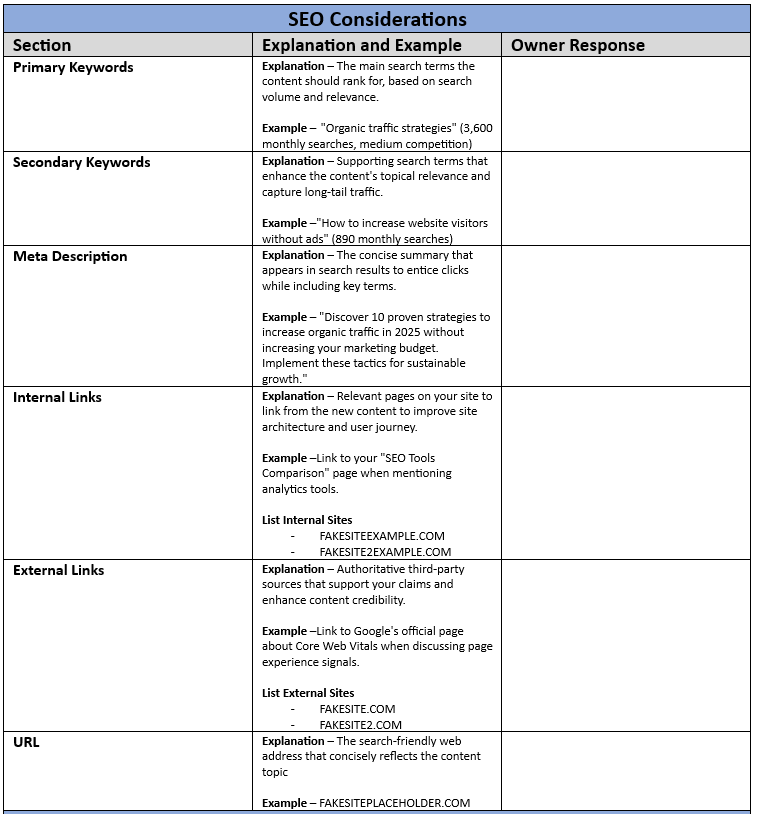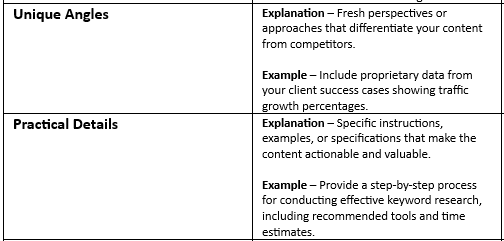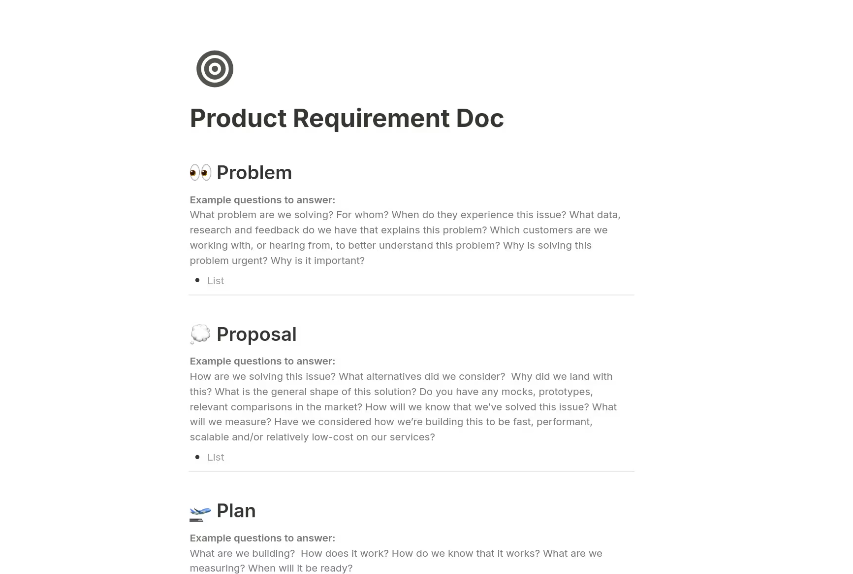Content Brief Template: Craft Amazing Content Every Time
Written by David L Hicks – March 18th, 2025
The growth of content marketing has skyrocketed over the past couple of years. As a result, the content being developed has become more and more important. 90% of marketers include content in their marketing strategies. With content at a premium, the quality of the content becomes more important.
The development of a content brief will help your organization’s content. A content brief template helps you create clear guidelines for your writers, ensuring consistency and quality in your content. A content brief is another weapon in your content strategy arsenal, along with others, including your content strategy template and content distribution plan. This article will walk you through developing an effective content brief template. The content brief you develop will have all the primary elements to develop amazing content.
Table of Contents
ToggleWhat is a Content Brief?
A content brief is a document that guides content teams in creating content. It is important because it helps ensure alignment with your organization’s business objectives and content marketing strategies.
As a solopreneur blogger, I initially underestimated the importance of a content brief, which is odd because the documents we develop, such as guidelines and standards, are so important in my Information Security profession. The guidelines and standards that dictate how the employees within the organization act.
Content Brief Template Benefits
The benefits of using content briefs extend beyond what we’ve already touched on. Using content brief templates streamlines the content creation process by providing a structured framework, which ensures consistency and saves time.
Other benefits include:
- Content development definitions
- Better understanding of your target audience
- Identifies the desired tone
- Better communication among team members regarding the content’s central goal
Key Elements of an Effective Content Brief
Content briefs vary depending on the organization that uses them and their purpose. However, although they generally differ, they do share several key elements. The key elements include:
- Content purpose
- Content goals
- Content scope
- Content audience
There are some elements that I would argue should be considered key elements.
- Tone
- Style
- Format
- Structure
I recommend adding a word count and an additional comments/notes section to your brief. These additional elements help ensure your content feels and looks the same. For example, the policies, procedures, guidelines, and standards we use in my organization read the same, and the documents are structured and formatted the same way.
Before you begin building your content brief, please download the content brief template.
Content Brief Template Example

As shown in the example above, the template lists key sections and provides detailed explanations and examples of what should be documented in the owner response column. You will respond to each section in the owner’s response column. The explanation and example sections assist your content development team.
Although it’s not pictured here, an additional comments section is particularly useful for adding article-specific comments, enhancing clarity by including additional information crucial for the article’s success.
Creating Your Content Brief
It’s important to understand that developing a content brief takes time and teamwork. Zenbrief minimizes the time it takes and simplifies your writing process by automatically generating a pre-filled brief with key information. The pre-filled information includes key terms like keywords and frequency. This can save time for organizations with a high publishing output rate (over 3-5 weekly articles).

(Source – Zenbrief)
Ensure you perform the following essential items regardless of your approach when developing your content brief.
Defining the Working Title
A working title helps the writer focus on the content’s core idea. Focusing on the main objective early in the writing process will bring the rest of your work into focus. Make sure your title matches the intention of your content. For example, a title might be “10 best techniques to improve on-page SEO.”
Setting Clear SMART Goals
Clearly defined SMART goals provide essential context, enhancing the writer’s focus and ensuring the content meets its intended purpose.
SMART goals are specific, measurable, achievable, relevant, and time-based. Because they aren’t vague, this type of goal allows individuals and team members to define and reach them properly.

(Source – Indeed)
Identifying the Target Audience
Effective content briefs prioritize understanding the target audience to tailor the content appropriately. Insights on the audience’s preferences and pain points are crucial for crafting relevant and engaging content. You don’t want to build content that doesn’t take the audience into account. If you do, your content becomes useless.
Documenting the Call to Action (CTA)
A clear call to action (CTA) guides user engagement and outlines the next steps. CTAs are crucial transitions in the buyer’s journey, guiding users on the next steps.
Well-designed CTAs enhance the user experience by clearly indicating the desired action and simplifying navigation. They should be prominently featured to catch users’ attention quickly. A great example of a CTA is “Click on this link to see your offer.”
Identifying the Buyer Journey Stage
Understanding where your buyer is in their journey is important to the success of your content brief template. The document should indicate which phase of the purchase decision process (awareness, consideration, decision) this content targets. Knowing where your buyer is in your journey will help you develop more precise content for those buyers. You don’t want to create awareness-based content for people in the decision phase.
SEO Considerations in Content Briefs

Incorporating SEO into content briefs aligns with user intent and maximizes organic traffic. An effective SEO content brief aligns content with specific organic traffic goals, meeting both user needs and search engine criteria. SEO is something you don’t want to ignore. Without SEO, you limit your content’s ability to find an audience. I initially ignored this when creating my content. As I built this site, I put more and more emphasis on SEO.
Choosing Primary Keywords
Selecting a primary keyword helps define the content’s central concept. Tools like Ahrefs Keywords Explorer can provide deeper insights into keyword intent. The tools can assist you in selecting relevant keywords. Make sure you add primary keywords in the SEO meta description. Performing that action allows search engines to highlight matching keywords from the user’s search, and in the end, it improves your content’s visibility.
Including Secondary Keywords
Secondary keywords broaden the content’s scope and improve search visibility. They support the main keyword/topic, broadening the content’s appeal and relevance. Secondary keywords are also identified as semantic keywords.
Writing SEO Titles and Meta Descriptions
Compelling titles and meta descriptions improve click-through rates from search engine results. SEO titles should include primary keywords to enhance visibility, while meta descriptions should attract clicks.
Document your URL
Noting your URL is mainly for housekeeping purposes. You want to know which content brief template ties to which posts. It helps your team know where your content ties back to your website.
Structuring the Content
Content briefs act as a roadmap, ensuring clarity in messaging and direction. Effective structuring enhances reader engagement and comprehension.
Sections for suggested headings and SEO essentials streamline the writing process, providing clear structure. This framework enhances user navigation and retrieval, making updates easier.
Word Count and Length
A target word count ensures thorough topic coverage while also remaining flexible. According to Yoast SEO, a blog post should be over 300 words for SEO. In general, 1,500 to 2,000 words are highly recommended.

(Source –Yoast)
Internal and External Links
Leveraging external links improves your content’s credibility and relevance. Internal links improve user retention by directing them to relevant content, enhancing the overall experience. External links to authoritative sources enhance credibility by demonstrating research depth and providing context.
Competitor Analysis
Analyzing your competitors’ articles and keywords will help you better understand what you may be missing. When reviewing your competitor’s content, you should also analyze metrics like word count, content quality score, and readability. Competitor analysis can even reveal popular content formats and effective strategies for you to leverage with your content.
Personalizing Your Content Brief
Personalizing your content makes it unique. Without adding your personal touches, your content won’t stand out as well as your competitors’.
Adding Unique Angles and Practical Details
Outside of highly technical content, your audience wants to read about your unique angles and personal experiences. Within your content, use brief templates, add a couple of personal experiences, and provide practical details you want to include. Below are examples documented in my content brief template:

Including Applicable Sub-Topics
Document key related themes that comprehensively address the main topic. Adding subtopics helps ensure proper coverage of your main topic. For example, you want to include a section on “measuring organic traffic quality metrics” to help further the point of your main topic, “demonstrate ROI of the strategies.”
Content Brief Templates for Different Needs
Not all content briefs are the same. They have different purposes and objectives. Below is a list of some of the more popular content briefs.
Technical Content Templates
Technical content templates simplify the communication of complex technical subjects. They are popular for technology-based content, such as how-to guides and descriptions of tech and other software.
Some key elements of a technical content template include the following:
- Executive summary or overview section.
- Product technical specifications (requirements).
- Implementation steps or methodology.
- Troubleshooting guide or common issues section.
Slite is a knowledgebase platform that organizations use to manage their documentation. Its technical content template has several key elements, including a product overview section, objectives, and features, among other requirements.

(Source – Slite)
As shown in the picture above, the technical document outline describes a detailed summary of the Acme CRM product’s overview, objectives, and product features. The product code is also displayed.
Product-Focused Content Templates
Product-focused content templates help organizations develop better content about their products. An organization that does an excellent job of helping with those briefs is Notion, which is a workspace and productivity tool that allows users to create notes, tasks, wikis, and databases.
Notion offers product templates to customers, among others. Their product content templates help organizations build product-centric documentation that aligns with the products they represent. Below is an example from one of Notion’s content templates they offer customers.

(Source – Notion)
Marketing and SEO Focused Templates
An SEO focused template’s purpose is to align marketing strategies with search optimization techniques. Using these templates, gives marketers the ability to integrate SEO requirements like keywords and meta data into their marketing strategy.
These templates leverage keyword research to create targeted marketing messages, boosting organic traffic. Backlinko is an excellent example of an SEO marketing content template. Backlinko is a resource hub and SEO training company that provides SEO best practices, link-building strategies, and content marketing advice.
Below is an example of some key elements covered in their SEO marketing content template, which is downloadable on their website for visitors.

(Source – Backlinko)
Conclusion
Creating a content brief is an essential skill for any content developer. Whether you are focusing on SEO, structuring your content, or identifying your target audience.
Mastering the skills of creating content briefs enhances the quality and effectiveness of your content. It also streamlines the entire content creation process. Using structured templates and incorporating SEO considerations ensures that your content meets your audience’s needs. Keep refining your briefs, stay aligned with your marketing goals, and watch your content strategy thrive.